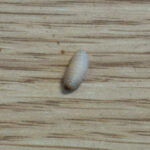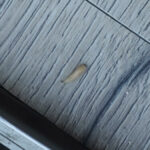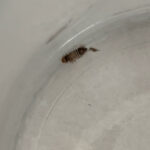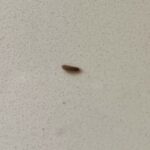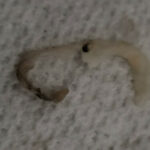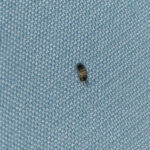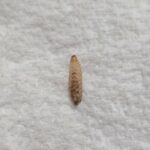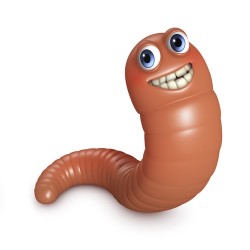On a recent morning, a reader found three white worms in different parts of her house. The white worms, which are actually not entirely white worms because they have some brown coloration on them, is about three quarters of an inch (or 20 millimeters) long. The worm is also “fat,” according to the reader, and has a big, round head. Finally, the worm’s body appears to be segmented and it has what look like “small pinchers” on its posterior end. So, the reader is dealing with a fat, white worm (plus some brown coloration) with a big head, a segmented body, and small pinchers, and her find has left her “so creeped out.” What might this fat, white worm be? Is it even a worm, or might it be a larva (or rather, larvae, since our reader found three)?
Unfortunately, the reader submitted no picture of the creature she found, which makes identifying it harder. However, her description of it was fairly thorough, so we have a good guess: we think that she found carpet beetle larvae, one of the most common household pests out there (and one of the creatures we are most frequently emailed about).
Carpet beetle larvae are obviously the larvae of carpet beetles, which means they aren’t worms (even though their bodies are somewhat worm-like, although interestingly this is less true of carpet beetle larvae than it is of other types of larvae). There are actually a few different kinds of carpet beetles that are commonly found in houses, including the varied carpet beetle and the black carpet beetle. The larval form of black carpet beetles tend to be larger than the larvae of varied carpet beetles, so if our reader is dealing with carpet beetle larvae, perhaps she is dealing with black carpet beetle larvae. However, we should note that black carpet beetle larvae still only grow to about a half an inch in length, which is shorter than our reader’s find, according to her estimate, but perhaps she slightly overstated its length. And besides that, some types of carpet beetle larvae are longer than a half inch anyway.
Carpet beetle larvae tend to be carrot-shaped, which means they have big heads (relative to the rest of their bodies). They are often brown or tan with white stripes, but often the opposite is true: they look primarily white (or whitish – sometimes they are a cream or yellow color), and then it looks like they have brown stripes. This is perhaps what the reader meant when she said the “worm” looked segmented. The reader also mentioned that the creature she found looks like it had small “pinchers” on its end. If she did in fact find carpet beetle larvae, she is probably referring to the long setae (hair) that gathers at the end of some types of the larvae.
We can’t be sure that the fat, white “worms” our reader found are carpet beetle larvae, but this is our best guess based on the information we were given. The reader was right to be “creeped out,” not because the carpet beetles will harm her, but because they can cause damage to things in her house (like clothing and furniture) and they can also get in her food. For this reason, she should look to address the problem by aggressively cleaning. She has to break the life cycle of the beetles by eliminating any trace of life. A good vacuuming is in order, and clothes that are lying around should be washed. For now, though, we would recommend our reader look into carpet beetle larvae, confirm that she has them, and then read up on how to get rid of them if she thinks she has a problem.
All About Worms is always free, always reader-supported. Your tips via CashApp, Venmo, or Paypal are appreciated! Receipts will come from ISIPP Publishing.



